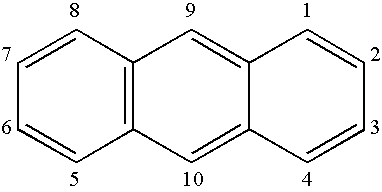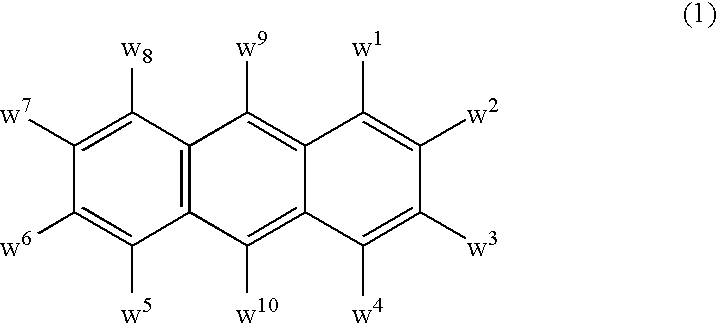Electroluminescent device including an anthracene derivative
an anthracene and el technology, applied in the direction of organic semiconductor devices, discharge tube luminescnet screens, natural mineral layered products, etc., can solve the problems of poor stability, many undesirable applications, and the performance limitations of anthracenes described previously, so as to improve the emission efficiency and stability, improve the oled properties, and improve the drive voltage
- Summary
- Abstract
- Description
- Claims
- Application Information
AI Technical Summary
Benefits of technology
Problems solved by technology
Method used
Image
Examples
example 1
Preparation of Inv-12.
[0187] 9,10-Dibromo-2-chloroanthracene was prepared by the following procedure. 2-Chloroanthracene (5g, 23.5 mmol, 1eq) was suspended in 100 mL of methylene chloride, followed by the addition of N-bromosuccinimide (8.36 g, 47 mmol, 2.0 eq). The slurry was stirred at room temperature, after 1 h only a trace of monobromo material was detected by thin layer chromatography analysis. The flask was heated in a warm water bath. Within a few minutes, the solution cleared and turned orange, followed by the precipitation of yellow solid. Stirring became difficult, therefore an additional portion of 50 mL of methylene chloride was added, and the mixture was stirred at room temperature for an additional hour, to completion. The yellow precipitate was isolated by filtration, and the solid cake washed with acetonitrile. During filtration, more solid had precipitated out in the filtering flask. A second crop of solid was isolated by filtration and combined with the first cro...
example 2
Fabrication of Device 1-1 through 1-6.
[0189] A series of EL devices (1-1 through 1-6) were constructed in the following manner. [0190] 1. A glass substrate coated with a 25 nm layer of indium-tin oxide (ITO), as the anode, was sequentially ultrasonicated in a commercial detergent, rinsed in deionized water, degreased in toluene vapor and exposed to oxygen plasma for about 1 min. [0191] 2. Over the ITO was deposited a 1 nm fluorocarbon (CFx) hole-injecting layer (HIL) by plasma-assisted deposition of CHF3 as described in U.S. Pat. No. 6,208,075. [0192] 3. Next a layer of hole-transporting material 4,4′-Bis[N-(l -naphthyl)-N-phenylamino]biphenyl (NPB) was deposited to a thickness of 75 nm. [0193] 4. A light-emitting layer (LEL) at a thickness shown in Table 1a and corresponding to C-1 or Inv-1 (see Table 1a) and including light-emitting material, (D-1), at the level shown in Table 1a was then deposited. [0194] 5. An electron-transporting layer (ETL) of tris(8-quinolinolato)aluminum (...
example 3
Fabrication of Device 2-1 through 2-6.
[0201] A series of EL devices (2-1 through 2-6) were constructed in the same manner as devices 1-1 through 1-6 except the LEL host was C-1 or Inv-2 (see Table 2a). The LEL emitter (D-1) level, the thickness of the LEL, as well as the ETL thickness are also shown in Table 2a.
[0202] The devices were tested for luminous efficiency and color at an operating current of 20 mA / cm2 and the results are reported in Table 2b in the 5 form of luminous yield (cd / A), efficiency (w / A) and 1931 CIE coordinates. Drive voltage is reported in volts.
[0203] Device stability was determined by operating the device (40 mA / cm2) at ambient temperature for 350 hours. The percent luminance remaining after 350 hours relative to the initial luminance is listed in Table 2b.
TABLE 2aLEL and ETL for Devices 2-1 through 2-6.LELEmitterETLLELThick.LevelThick.ExampleHost(nm)(%)(nm)2-1ComparativeC-1300.75252-2InventiveInv-2200.75352-3InventiveInv-2300.75252-4InventiveInv-2400.75...
PUM
| Property | Measurement | Unit |
|---|---|---|
| thick | aaaaa | aaaaa |
| operating voltages | aaaaa | aaaaa |
| wavelength range | aaaaa | aaaaa |
Abstract
Description
Claims
Application Information
 Login to View More
Login to View More - R&D
- Intellectual Property
- Life Sciences
- Materials
- Tech Scout
- Unparalleled Data Quality
- Higher Quality Content
- 60% Fewer Hallucinations
Browse by: Latest US Patents, China's latest patents, Technical Efficacy Thesaurus, Application Domain, Technology Topic, Popular Technical Reports.
© 2025 PatSnap. All rights reserved.Legal|Privacy policy|Modern Slavery Act Transparency Statement|Sitemap|About US| Contact US: help@patsnap.com



